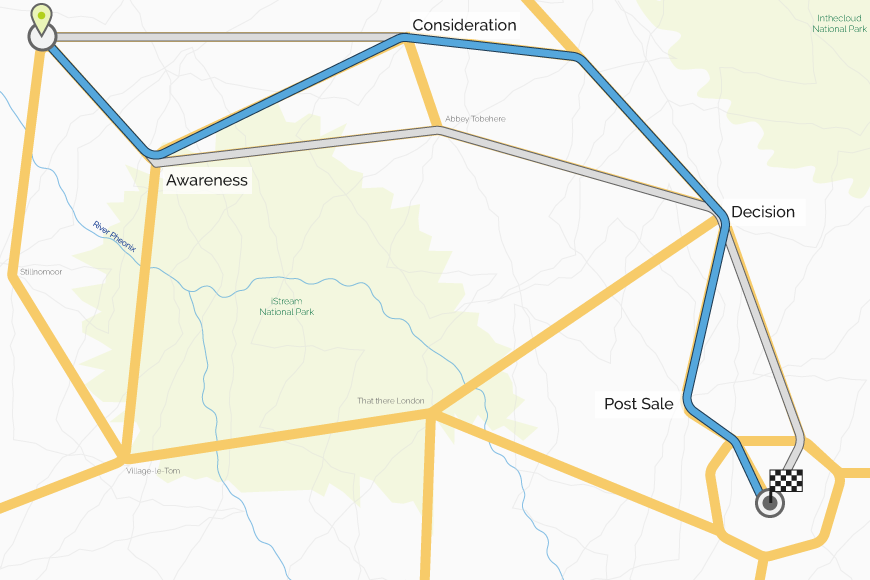Customise Your Customer Journey
4 Mar 2019
If only there was a foolproof textbook or website or tutorial that outlined “the perfect customer journey”! Every business owner would just need to spend a couple of hours reading and before you know it, each any every one of them will be geared up to offer perfect customer service!
So what exactly is the customer journey – where does it start and where does it end? Well obviously, it’s not a one-size-fits-all concept. Buying a bar of chocolate from a supermarket and buying a house from an estate agents are very contrasting experiences, and similarly buying a subscription-based service is entirely different once again.
Let’s start by considering each of those three scenarios, from a client perspective – what steps is the customer likely to take?
The Hungry Shopper: Awareness – Consideration – Decision – Post Purchase
I’m hungry, but what do I want to eat!? It needs to be quick and convenient as I’m on the go. Actually I’m not starving but just want to satisfy my sweet tooth, some chocolate will do the trick. Ah there’s a shop, I know they will sell my favourite chocolate bar so I can just go in and buy it. Decision made – I went into the shop, bought and ate the snack and now I’m happy.
The House Hunter: Awareness – Consideration – Decision – Post Purchase
I’ve got a new job in another part of the country, so I will be moving house. I need to get my current place valued and compare that with the house prices for my new location. As well as price I need to consider distance from work, local amenities and lots more. I’ll give a couple of estate agents a complete spec and let them work on some choices for me. Once I’ve narrowed my options down, there are still a lot of factors involved in my final decision. After I have made the purchase there are formalities to complete, insurances and other paperwork to consider, so it will be an ongoing process for some time to come even after I’ve moved.
The Business Owner: Awareness – Consideration – Decision – Post Purchase
My business could do with a nice new software tool to deal with problems we have with all the sales guys using separate spreadsheets to store their data. We have looked at our business model and processes and identified that a CRM solution is exactly what we need, so we’ve started to look at the market and check out our options. We’ve decided to go for an online subscription-based platform, so that’s the first decision made. Now we need to check out the providers, make sure their solution meets our requirements and have a look at the extras that they offer – support, upgrades, maintenance, training and so on. Once we’ve made a shortlist, ideally we want a trial or a demo of the product so we can review it in the context of our requirements. Finally having made a decision, and we now need to manage the set-up and ongoing implementation. As we’re taking on a rolling subscription, the post-purchase phase becomes a long-term ongoing partnership with our CRM provider.

Watch and learn
If you're looking for further information on how specific features and functionality play out in OpenCRM, why not click to check out our webinars?
watch nowAs you can see the customer journey will vary depending on the type of product or service you offer and the anticipated level of interaction with your clients. How can the Service Provider manage the customer steps?
Having looked at this from the perspective of a customer, we need to see how a business owner might tackle these challenges. Firstly, they will need to define each of the steps of the journey and plot the road ahead.
As we discovered, some businesses have more touch points with their potential customers than others which is where the bespoke nature of this plan comes into effect. Depending on your sales platform being physical, or online, or a mix of both, you’ll need to monitor customer behaviour in different ways.
Satisfying My Sweet Tooth: Before – During – After
If you sell the chocolate bar you hope the client wants, you need to make them aware of this, either by direct advertising or promoting brand awareness so the client can associate that product with your store. You need to be open when you are likely to have passing trade. The chocolate (as with all other products) needs to be easy to find in-store and should be priced competitively. Some intelligence needs to be applied to product placement to give you the opportunity to cross-sell other items. The staff at your checkout should be friendly, or the self-checkout system you use needs to be easy to use. And the software you use to log transactions should give you the information needed to be able to report on sales, so you can keep track of stock and trends. So for even a basic transactional relationship there is a lot to consider.
A Roof over My Head: Before – During – After
If you have a chain of estate agent shops, they need to be well located, with a good display of properties on offer. As you are likely to have too many properties to advertise in a window, you might consider using a screen showing a slideshow of properties and draw attention to your online presence. Using analytics to track online visitors gives you statistics about your web visitors and using clean and easy webforms makes it easy for potential clients to let you know what they need form you.
Once you have captured the prospect’s requirements, you need to put your account managers’ and salespeople’s skills to use, to help them guide the client to the property of their dreams. As you no doubt know this can be an arduous journey for the client due to the many factors involved you need to be aware of the details of each client in order to make the sale as pain-free as possible. Even if it doesn’t come through, ideally you need to leave a positive impression so that when your clients comes back to the table, it’s you that they will come to.
After the sale you hopefully have a satisfied customer and you can use their experience to help you improve and enhance your customer experience, perhaps by asking for feedback. A great sale may mean you can get a glowing testimonial from the client and you may have established an advocate who will recommend your services to their friends, colleagues and family.
The Software Solution: Before – During – After
The online subscription-based services is a crowded market, so you need to work hard to make your business stand out. This could mean anything from making your website attractive, working on your Google ranking, getting testimonials from happy clients or even spending money on advertising. You’re not likely to have a physical presence so you need to find other ways of getting your name under people’s noses.
Analytics can give you valuable tracking information so you can judge the performance of your online presence and see where you need to make improvements, for example if you see lots of people navigating to an enquiry form page, but not getting many actual submissions then you may need to rethink how that form works.
Once a person has engaged with you, you need to tailor your customer journey to meet their requirements. Whether this means setting up a trial for them, arranging a meeting or a custom demo, you need to see where they are in their decision process and how you can help move them along in the sales cycle. In fact in this example you are well positioned – as you are offering a CRM service you will no doubt be harnessing the capabilities of that system yourself and so you and your team can monitor customer touchpoints and provide the client with personalised whenever it is needed.

Don't just take our word for it
Click to read how other companies have benefited from using OpenCRM. From out-of-the-box implementations to businesses that needed bespoke development to fit their unique approach - we've seen it all.
find out moreWhereas in the other examples I’ve talked about the sale is the conclusion of that transaction, for a subscription-based service, this is really just the beginning. The ongoing use of your service means that the client needs to be on your radar at all times, so you can make sure the relationship stays fresh and positive.
One Size Doesn’t Fit All
As you can see from these three generic examples, there are countless different models that look at how the customer journey works. Furthermore within different business verticals and industries, different players will tailor that journey and make it unique to them, turning what might seem like an obvious mundane task into a fine art that leaves a positive impression.
However what all the processes have in common is that the relationship with the client will often follow a similar pattern with particular steps being taken in a certain order. As outlined in the example of the software solution example, a CRM solution is an ideal place to store the details of your client interactions – past present and future. You can use automation tools such as Action Plans to prep the different stages of the customer journey and ensure that no matter what your business is, none of your prospects or existing clients fall through the cracks.
The ultimate goal is that when a person needs a service that you offer, your customer journey makes them want to come back to you time and time again.
My role is to build our Customer Success team and I work with our clients and prospects helping them get the most from their subscription – it is a fun challenging role as no two days are the same. When not in the office I’ll be either making a noise on my guitar or getting my trainers on for a run out in the Yorkshire Dales, North York Moors or the Lake District.